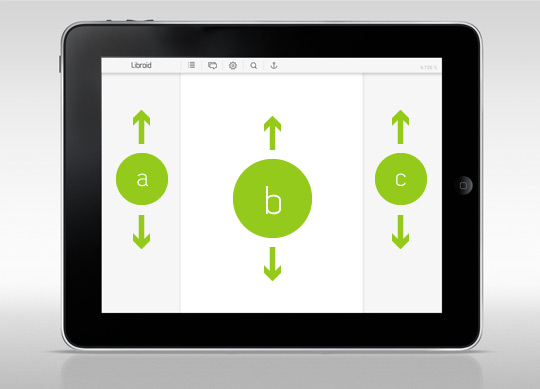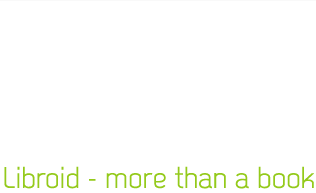Libroid
Libroid – for the future of reading
The book is shedding its paper skin and emerging as a dataset in a digital reading device. This opens it up to an entirely new continent of possibilities in design and expression. At the same time the competition from other media poses a threat to its very being. How do we hold on to the dignity and clarity of the book, the “purity” of the reading experience, in a flickering multimedia world, when old habits and sensibilities, both tactile and material, are on their way out?

The Libroid is a direct response to the digital revolution. It is stepping up to preserve the essence of the disembodied book. It will not replace the book but rather extend the media potential of the world of reading. Hand in hand, not locking horns, they share a future. Just as radio continues to flourish alongside the TV: despite all fears to the contrary, it was never squeezed into a corner and can look forward to a rosy future.
Libroids free books from the constraints of print. They open up new presentation forms that also benefit readers, providing extra content alongside the text. The first thing you will notice about a Libroid is that page-turning has been replaced by scrolling text. Naturally, this makes page numbers are redundant and they are accordingly absent from the Libroid. Your position in the text is indicated in percentage terms.
In this sense the Libroid is re-establishing a connection, in the history of the written word, with writing tablets and the scrolls that followed them. Pages and page-turning were only introduced with the codex, with the stacking, bundling and – later – binding of separate pages in Roman times. The printing press turned this into a mass product.
Since authors replaced their typewriters with computers, they have essentially been writing on scrolls of continuous text. It has long been the norm to spring back and forth within the manuscript, chopping and changing, adding bits, moving whole passages around.
The readers, on the other hand, with their printed books – or even with ebooks, the digital replicas – continue to move within Gutenberg’s galaxy. Thanks to their virtual and often beautifully programmed “page-turning” function, ebooks recreate a pleasurable experience that has a 500-year old tradition in the paper book.
Libroids are different: they reflect the working process of the writer. In this they also draw on the psychology of perception when it comes to the legibility of blocks of text, which we can only apprehend in a central “window”. The optimal width of a line, depending on typeface, is approximately 60 keystrokes. So the printed book serves as a tried and tested model for the layout of the text, even on digital reading devices.
Out of the corner of our eyes, however, we also see things and things happening outside our central field of vision, albeit with less focus. Car drivers can concentrate on the traffic and keep an eye on the rear view mirror and the speedometer at the same time. Images, patterns and symbols are easier to recognise, which is one reason why digital formats – on a speedometer for example - have not replaced dials.
Lessons like these, in the ergonomics of reading, have determined the Libroid’s design. Since text can be read as if from a scroll, it made sense to keep the other elements of the Libroid within a similar paradigm. The key to Libroid technology is the triple column. In the central area lies the text, where it can best be absorbed by the eyes; in the margins left and right are narrower columns, which are read by the “third eye”. These might contain photos, Internet links and original sources, or even entire books, maps, musical scores, graphics, footnotes etc.
In order that readers perceive them without being unduly distracted from the text, these additional elements are scaled in small formats (such as thumbnails or icons). It is up to the reader to click on these symbols. Once they are closed again, an anchor function directs you back to where you left off reading.
The three columns are dovetailed in such a way that the related contents of, for example, text, image, link or source, always line up at the centre of the screen – “at eye level”. If you scroll through one of the columns, the others follow, realigning the linked content.
By rotating the Libroid from a horizontal to a vertical position, the two side columns disappear as if by magic, to allow for “pure” undistracted perusal of the central scroll text.
Quiet, concentrated reading of the main body of text is – literally – the central focus. For this reason, Libroids deliberately steer clear of any hectic, complicated layouts which might distract the reader. It is left up to the individual to decide to enter worlds beyond the text.
The Libroid lifts the book out of flat plane and into new spatial and temporal dimensions. Sources can be buried beneath the text and summoned to the surface at will. In the temporal axis they can be changed and added to at any point in time – by the author - who can update the text – or interactively by the reader, who can add notes and Internet links. The Libroid breathes new life into the book.
The dynamic “content management system” of the triple column technology enables the Libroid to house several language-versions of any particular text, in identical formats. And new translations in other languages can be added at any time. The various translations are also dynamically linked so that readers can switch between languages at will.
Books can be published, purchased and downloaded simultaneously all around the world. Readers can also compare and exchange their notes and additional links. This “social reading” function opens the doors to virtual reading communities and book clubs that extend across the globe.
Part of the process of regeneration involves the introduction of new enjoyment factors to mitigate the loss of old ones, or perhaps even allow them to be forgotten. Touch-sensitive screens replace the traditional book “feel” with new tactile possibilities that can be grasped intuitively. Holding, pressing, typing, pulling and wiping as well as 90 degree rotations, expand the reader’s room for manoeuvre. This of course makes it easier for both much older and younger readers to adapt to the new technology.
The three text columns of the Libroid feel almost as if they are joined by elastic. Every time the reader scrolls through the content they experience a satisfying sensation of playful control. When the three moving columns align their related contents at the centre of the screen, it’s like playing a one-armed bandit.
The Libroid publication process is also about making it possible for authors to create their own works for multimedia reading devices. They will be able to produce and distribute them through the Publishers of Unprinted(before it was unprintable!!) Books - or, for a licence fee that covers the use of the technology, publish them independently.
The protection and extension of the autonomy of the author in the face of technological dictates, was a driving force in the development of the first Libroid. You, the author, are the best guarantor, in the transition from the unmoving to the moving medium, to ensure that the book, as a disembodied dataset, retains the maximum in character and dignity.

